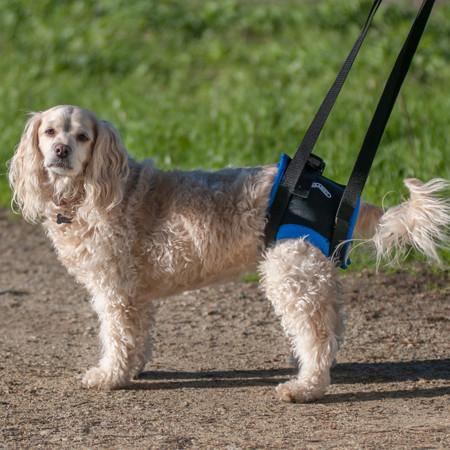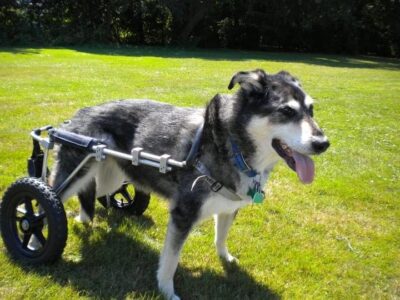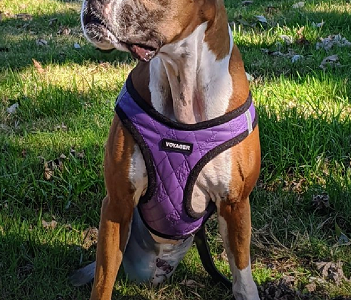
Table of Contents[Hide][Show]
Syringomyelia in dogs is a rare neurologic disorder that targets only a handful of breeds. Its primary victims are Cavalier King Charles Spaniels and according to experts if you have a Cavalier, they’re likely to have some level of the condition.
Cavalier King Charles Spaniels are special dogs and it’s hard not to fall in love with them. Just take a look at their soulful faces and big brown eyes and you’ll know what I mean. The first Cavalier I met was an adorable chocolate brown puppy a friend adopted. He had been sent to a rescue group because he was deaf.
That deafness is one of the one of the symptoms of Syringomyelia (SM). The condition causes a range of health problems that include: neck pain, leg weakness, facial paralysis and constant head shaking or scratching.
To fully understand this disease, it’s important to learn about your dog’s brain.
This post contains affiliate links. Our policy.

Ask & Discover
Get personalized content recommendations and answers drawn from our website. Simply type your question or topic of interest, and our AI assistant will help you find relevant articles, tips, and insights. You can also have a natural conversation to explore topics in more depth.
SM and the shape of a dog’s skull
The key to SM (also known as occipital dysplasia or caudal occipital malformation) lies in the shape of your pet’s skull. It’s also the reason Cavalier’s are predisposed. The breed has an abnormality in the shape and size of their skull which makes it too small to properly house the brain.
The abnormality doesn’t affect a dog’s intelligence, but the shape makes it harder for a liquid called cerebrospinal fluid (CSF) to work.
Cerebrospinal fluid encases a dog’s brain and spinal cord. It’s responsible for providing the area with nutrition, insulation and lubrication. The body also relies on CSF to remove waste.
The size of a Cavalier’s skull prevents CSF from flowing easily through the brain and down into the spine. It forces CSF to flow through a smaller than normal space. After time the fluid backs up, causing painful pockets and swelling in the spine and neck. Ultimately, these fluid sacs can crystallize and harden in the spine.
Because it takes time for this back up to happen, dogs show the first signs of SM between the ages of 6 months to 3-years-old.
Other dog breeds prone to Syringomyelia

Cavalierhealth.org says that SM was first identified in Cavaliers in the 1990s.
The condition also strikes these dog breeds:
Bichon Frise’
Affenpinscher
Boston terriers
Bull terriers
French bulldogs
Havanese
Maltese
Miniature Dachshunds
Miniature Poodles
Papillons
Pomeranians
Pugs
Shih Tzus
Staffordshire bull dogs
Yorkshire terriers
The symptoms of Syringomyelia
Here are the first symptoms pet owners’ notice:
Head scratching – A dog scratches or rubs their head excessively. It’s usually seen while a dog is walking on a leash. Researchers think this is due to pain or sensitivity in a dog’s neck when they move.
Air scratching / Phantom scratching – This form of scratching looks like its being done in mid-air. The dog never actually touches their body. It’s seen most often when a dog is walking or playing.
Pain – This primary symptom appears when a dog seemingly yelps or cries for no apparent reason. The episodes come and go or can happen when the weather changes.
Leg weakness / Lack of coordination – Some dogs develop a limp or have trouble getting on and off the furniture or the floor. Pet owners also notice their dog compulsively licking at their paws or legs.
These are the more subtle signs of SM:
Restlessness – A dog constantly shifts positions while lying down and can’t seem to get comfortable.
Head shaking and Lip-licking – Dogs shake their heads and ears or yawn excessively. Others continually lick their lips. It’s believed this symptom is a dog’s way of trying to clear pressure in their head.
Head rubbing – Another technique dogs use to relieve pressure is to rub their head or face into the floor.
Digging – Some dogs obsessively dig into the carpet or the sofa to soothe pain and pressure.

Get the Essential Guide
The Essential Guide of Products for Handicapped Dogs e-book is a labor of love for me. I wrote it to answer your most pressing questions about where to find the best products for your wheelchair dog. You’ll find products you didn’t know existed and each will improve your dog’s quality of life. Print a copy and keep it by your side.
Late-stage symptoms
As SM progresses, it can cause an array health issues. Some dogs have problems with their eyesight while others develop extreme stiffness in the neck, back or limbs. Dogs are also prone to head tremors and seizures.
Treatment options

Treatment for SM is limited, but veterinarians have made advancements in the past few years.
First an MRI is ordered to diagnose the condition. This imaging test is the most precise way to confirm SM. It enables a veterinary neurologist to locate the specific areas in the brain and spine where fluid is backing up or flowing abnormally.
If a dog is diagnosed with a mild case of SM, Gabapentin is often prescribed to relieve pain and corticosteroid medications like Prednisone are offered to reduce inflammation. Veterinarians also recommend the use of antacids because of their ability to reduce CSF. Check with your vet for the right product for your pet.
Physical therapy is often recommended as well. It builds muscle mass and improves circulation.
In more severe cases, the buildup of fluid is surgically drained from the spinal cord. And in extreme cases surgery is performed on the vertebrae and skull to relieve pressure.
The prevention of SM
Syringomyelia appears to get worse with each generation of Cavaliers once the condition has been diagnosed in a family line. Dogs tend to show signs of illness at earlier ages as well.
To prevent this from happening, national and international dog associations have created an official breeding protocol for Cavalier King Charles Spaniels. The protocol recommends that susceptible dogs undergo an MRI and if SM is confirmed, they are removed from breeding future litters.
The Cavalier puppy I know

At this point in time, the adorable brown Cavalier puppy my friend adopted is healthy and doing well. Deafness is his only symptom of SM. He’s learned to understand sign language and is having a happy puppy life.

My favorite harnesses for disabled dogs.





Hi, I have a two-legged Chihuahua. She was born without her front legs. I am looking for information on Syringomyelia. She is 5.5 years old. She has wheels but because she only weighs 6 pound she gets carried around a lot. She occasionally licks her back paws and will scratch her neck. Ear infections have been ruled out. Is it possible that she could be affected with Syringomyelia? I know an MRI is the definitive way to diagnose it but I was wondering if you have heard or know of any other 2 legged dogs that have been diagnosed with Syringomyelia. I’ve mentioned it to my vet but they’re non-committal. If I need to I will take her to UC Davis vet school for an MRI. I’m not sure her insurance will cover the cost if they think it’s a pre-existing condition. Thanks for any information. Sunny Powel
Sunny, Thanks for reaching out about your Chihuahua. Syringomyelia has more to do with the small size of a dog’s skull rather than missing limbs. You might want to discuss your concerns with your primary vet and see if it’s time for a consult with a specialist.